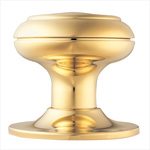Caring for your Door Handles
Brass Products
 Carlisle Brass products are protected by the most advanced lacquer available and under normal circumstances should give many years of service. They should be cleaned with a cloth moistened with soapy water or alternatively wiped over with a soft cloth with beeswax. UNDER NO CIRCUMSTANCES USE ANY FORM OF METAL CLEANER OR AEROSOL SPRAYS.
Carlisle Brass products are protected by the most advanced lacquer available and under normal circumstances should give many years of service. They should be cleaned with a cloth moistened with soapy water or alternatively wiped over with a soft cloth with beeswax. UNDER NO CIRCUMSTANCES USE ANY FORM OF METAL CLEANER OR AEROSOL SPRAYS.
However, after a period of time the lacquer coating, especially on external fittings, can suffer a possible breakdown. Therefore, the life of the lacquer is beyond the manufacturer's control and cannot be guaranteed. When the lacquer coating has broken down, remove the brass fittings and coat using a soft brush with acetone thinner e.g. "Nitramores" according to the manufacturer's instructions. Completely dry the product using a soft cloth and metal polish, such as "Brasso" or "Duraglit". At this stage the product can either be re-lacquered or polished as and when required.
A fresh coat of lacquer may be applied, but Carlisle Brass strongly recommend that, especially for external use, you should leave the item unlacquered.
Chrome Products

Carlisle Brass quality chrome products are virtually maintenance free. However, deposits will accumulate especially on external fittings. Carlisle Brass therefore recommend regular cleaning with a soft cloth and non-abrasive wax polish.
This will ensure the original appearance is maintained.
Stainless Brass PVD

These products have an advanced vacuum treated process and Carlisle Brass can offer a full 25 year replacement guarantee with the Exclusive Stainless Brass Finish.
The technology involved in this process renders this surface impervious to damage in normal use including oxidation, wear and abrasion. All lacqered brass items require regular cleaning with non-abrasive wax polish.
Carlisle Brass recommend the removal of suface dirt by dusting with a soft cloth. Stubborn stains can be removed with the use of white spirit or similar spirit based products.
Cleaning and Caring for Stainless Steel
 Why Clean Stainless Steel?
Why Clean Stainless Steel?
Stainless Steels need to be cleaned for aesthetic considerations and to preserve corrosion resistance. Stainless steel is protected from corrosion by a thin layer of chromium oxide. Oxygen from the atmosphere combines with the chromium in the stainless steel to form this passive chromium oxide film that protects from further corrosion. Any contamination of the surface by dirt, or other material hinders this passivation process and traps corrosive agents, reducing corrosion protection. Thus some form of routine cleaning is necessary to preserve the appearance and integrity of the surface. Stainless steels are easily cleaned by many different methods. They actually thrive with frequent cleaning and, unlike some other materials, it is impossible to 'wear out' stainless steel by excessive cleaning. Stainless Steel performs best when clean - cleanliness is essential for maximum resistance to corrosion.
Stainless Steel Maintenance Program
All exposed stainless steel surfaces should be wiped over with a clean cloth and warm water with a mild detergent on a frequent and routine basis.
For more stubborn dirt or stains use mild, non-scratching abrasing powders such as typical household cleaners. These can be used with warm water, bristle brushes, sponges or clean cloths. For more aggressive cleaning a small amount of vinegar can be added to the powder.
Carbon steel brushes and steel wool should be avoided as they may leave particles embedded in the surface, which can lead to rusting.
Cleaning should always be immediately followed by rinsing in clean hot water and the surface then wiped completely with a dry towel.
The maximum recommendation for routine cleaning is once a month and more often in areas subject to heavy soiling or frequent use.
Where routine maintenance is considered a pre-requisite of compliance with an associated guarantee a 'Maintenance Log' should be kept for each installation.



